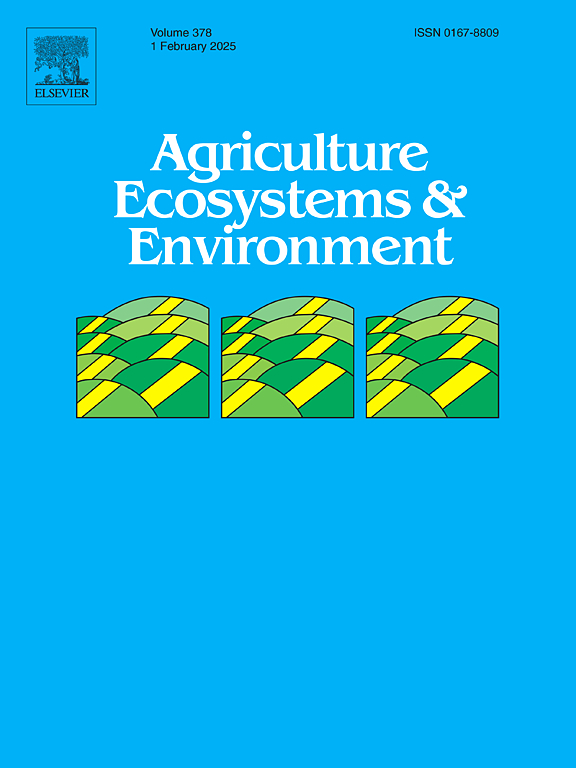Effects of novel P fertilizers on microbial abundance related to N and P cycling in two on-farm systems
IF 6.4
1区 农林科学
Q1 AGRICULTURE, MULTIDISCIPLINARY
引用次数: 0
Abstract
Phosphorus (P) is an essential macronutrient element for plant growth and development. Its limited availability makes alternative P sources crucial for fertilizer production. This study investigated the effects of three recycling-derived fertilizers with varying P solubility on microbial nutrient turnover at two fields in central Germany, Kiebitzbreite and Schmatzfelder Breite, which differ in management practices and soil characteristics. Samples were collected during the stem elongation stage of winter wheat from bulk soil and rhizosphere. Fertilization treatments included traditional triple superphosphate (TSP) and a no-P control (P0) for comparison. The abundance of microorganisms involved in P and Nitrogen (N) turnover was assessed by quantitative real-time PCR. Potential acid and alkaline phosphatase activity, mycorrhizal colonization rate, Carbon (C) to P, N to P ratios in the soil and the plant, and water-extractable P were measured. Although all treatments received the same amount of P, the differing solubilities of the fertilizers significantly affected water-extractable P levels, while nutrient ratios in the plant biomass remained comparable among sites and fertilizer treatments. However, the microbial strategies for maintaining P levels varied significantly across the sites. At the Kiebitzbreite, the site with silty loam texture and deep plowing, high ratios of available C and N to P in the soil were accompanied by high alkaline phosphatase activity and a larger abundance of arbuscular mycorrhizal fungi in the rhizosphere. Conversely, P solubilization was more pronounced at Schmatzfelder Breite, a site with finer soil texture managed by deep chiseling. Notably, the fertilization treatments influenced not only the abundance of bacteria catalyzing P turnover but also those catalyzing major steps of the N cycle, especially at Schmatzfelder Breite, where higher P solubility led to increased bacteria involved in N mineralization. This non-targeted effect on N cycling underscores the importance of fertilizer type, beyond just P supply, in influencing broader nutrient turnover dynamics. Our findings suggest that recycling-derived P fertilizers are promising alternatives to conventional P sources, though their on-farm impacts on microbial nutrient turnover vary significantly with site conditions and management.
新型磷肥对两个农场系统中与氮和磷循环有关的微生物丰度的影响
磷(P)是植物生长发育必需的常量营养元素。其有限的可用性使得替代磷源对肥料生产至关重要。本研究在德国中部Kiebitzbreite和Schmatzfelder Breite两个不同管理方式和土壤特征的农田,研究了三种不同磷溶解度的循环衍生肥料对微生物养分周转的影响。在冬小麦茎秆伸长期从散装土壤和根际土壤中采集样品。施肥处理包括传统的三联过磷酸钙(TSP)和无磷对照(P0)。利用实时荧光定量PCR技术对参与磷和氮(N)转化的微生物丰度进行评估。测定了潜在的酸性和碱性磷酸酶活性、菌根定植率、土壤和植物的碳(C)磷比、氮(N)磷比以及水可提取磷。虽然所有处理均施磷量相同,但不同肥料的不同溶解度显著影响水分可提取磷水平,而不同地点和施肥处理的植物生物量养分比例大致相同。然而,微生物维持磷水平的策略在不同地点差异很大。在基比茨布雷特(Kiebitzbreite),土壤中有效碳和氮磷比高,根际碱性磷酸酶活性高,丛枝菌根真菌丰度高。相反,磷的溶解作用在施马茨费尔德布雷特更为明显,这是一个土壤质地较细的地点,通过深凿处理。值得注意的是,施肥处理不仅影响了催化磷周转的细菌的丰度,还影响了催化氮循环主要步骤的细菌的丰度,特别是在施马茨菲尔德布雷特,更高的磷溶解度导致参与氮矿化的细菌增加。这种对氮循环的非靶向效应强调了肥料类型在影响更广泛的养分周转动态方面的重要性,而不仅仅是磷供应。我们的研究结果表明,循环衍生的磷肥是传统磷肥来源的有希望的替代品,尽管它们对农场微生物养分周转的影响因场地条件和管理而异。
本文章由计算机程序翻译,如有差异,请以英文原文为准。
求助全文
约1分钟内获得全文
求助全文
来源期刊

Agriculture, Ecosystems & Environment
环境科学-环境科学
CiteScore
11.70
自引率
9.10%
发文量
392
审稿时长
26 days
期刊介绍:
Agriculture, Ecosystems and Environment publishes scientific articles dealing with the interface between agroecosystems and the natural environment, specifically how agriculture influences the environment and how changes in that environment impact agroecosystems. Preference is given to papers from experimental and observational research at the field, system or landscape level, from studies that enhance our understanding of processes using data-based biophysical modelling, and papers that bridge scientific disciplines and integrate knowledge. All papers should be placed in an international or wide comparative context.
 求助内容:
求助内容: 应助结果提醒方式:
应助结果提醒方式:


